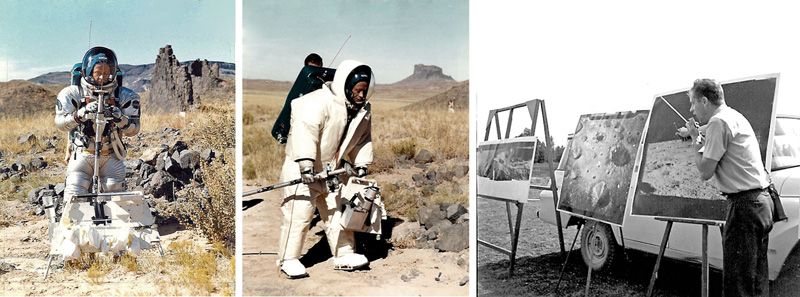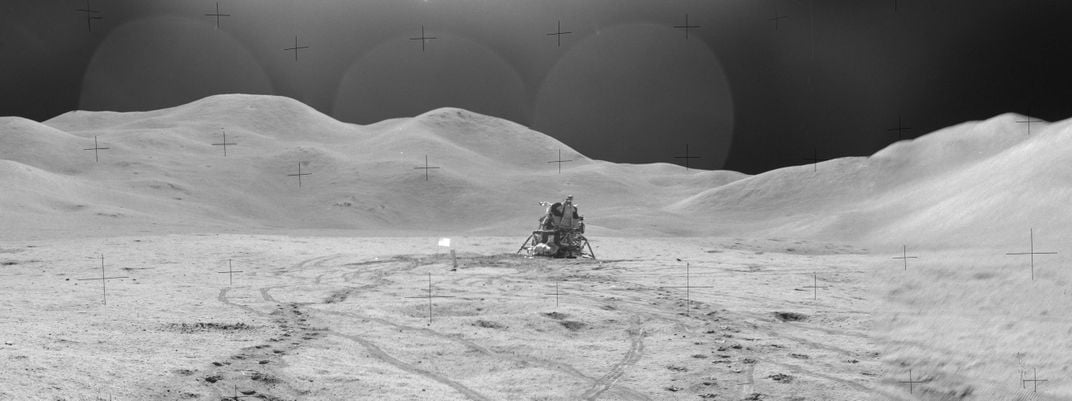Gordon Swann, Geology Teacher to the Astronauts
Remembering a pioneer of lunar exploration.
I was with the USGS in Flagstaff in the 1980s and had the opportunity to work with Gordon on some of the geologic problems of the Apollo 15 landing site. Gordon had brought Dave Scott, the Apollo 15 Commander, to Flagstaff for several days of geological debriefing. It was very instructive watching extravehicular activity (EVA) “moon walk” videos together and hearing stories of the great and hectic times of those days. As a result of some of this work, Gordon, Ron Greeley (my former academic advisor) and I published a paper on the geology of Hadley Rille –interpreting it as a lava channel that followed pre-existing structural depressions on the ancient non-mare, highland lavas. This realization – previously unrecognized – was Gordon’s observation; he noted the similarity of Hadley Rille to some other nearby structures (Rima Mozart) that were less well developed. Gordon’s key insights informed our effort to understand the termination of the rille into ancient structures north of the landing site (Rimae Fresnel), a relation previously unexplained.
It was the dedication, intelligence and hard work of people like Gordon Swann with the USGS that established field geology as the principal discipline for planetary surface exploration. Their work (honed doing terrestrial field work) showed, that while a machine can pick up a rock, only a trained field geologist (and those with team training and guidance) can uniquely collect relevant samples by understanding their associated context – the appreciation of the natural complexity of planetary surfaces required by field scientists accustomed to dealing with the complex and the fragmentary. This work continues with the Lunar Reconnaissance Orbiter (LRO), as scientists remotely map the lunar surface – advancing our understanding of the Moon, its geology and providing us with ever-expanding evidence of its unparalleled value and potential for space pioneering.
Gordon Swann will be greatly missed by his family and friends. But he has left us his recitation of The Cremation of Sam McGee by Robert Service, the poet laureate of the Yukon Gold Rush, beloved by all geologists.

As strange as it might seem now, a great debate raged prior to the Apollo landings as to whether field geology was even relevant to the human exploration of the Moon. This argument began even before the goal of a lunar landing was announced. Some scientists (notably Harold Urey, a Nobel Prize-winning chemist) viewed geology as a “second-rate science,” believing only chemists and physicists should address the questions of lunar origin, evolution and their implications for the early Solar System. Urey reasoned that he could deduce the history and composition of the Moon from basic principles of chemistry and physics. In an influential book (The Planets, 1952), Urey wrongly concluded the Moon was an ancient, unmelted primordial object, shaped by the cold accretion of leftover debris from the formation of the Solar System.
In contrast, Eugene Shoemaker of the USGS – a field geologist par excellence – argued, as a rocky planetary object, the Moon should be studied using the geological approach. He outlined the basic principles of unraveling the complex history of a planetary surface by geologic mapping in a series of milestone papers published in the early 1960s. He recognized units as three-dimensional deposits of rock, emplaced at the same time by comprehensible processes. Shoemaker knew he was young enough to be considered as a candidate to go to the Moon and much of his work in this area was done with that end in mind. His study of Meteor Crater in northern Arizona led to an understanding of the mechanics of impact cratering, insights he then applied to the craters of the Moon.
Shoemaker recognized it was likely that the dark smooth lunar maria consist of flows of volcanic rock, probably basalt, the most common volcanic rock on Earth. He also understood that over time, the bombardment of the Moon by micrometeorites would grind the surface into a powdery layer of unconsolidated debris, a layer he named regolith. Remarkably prescient, his model of the Moon’s geology was largely complete by the mid-1960s. (Gene didn’t get to walk on the Moon but he was honored for his contributions to science – and achieved his dream of going to the Moon by having some of his ashes sent aboard the Lunar Prospector orbiter that was crashed into the Moon on July 31,1999.)
In 1961, Gene Shoemaker established a center in Flagstaff, Arizona for USGS personnel who were working on lunar and planetary problems. He recruited many geologists eager to work on parts of his great vision. One of his recruits was Gordon Swann, a classically trained geologist with much field experience mapping parts of the American west. Gordon was assigned the task of working out the procedures astronauts would use on the Moon – to teach them not to simply “pick up rocks,” but to give them the knowledge and tools necessary to conduct field exploration. Field geology involves recognizing physical relationships, mapping the geometry and locale of outcrops (if any), and applying intelligent observation, recognition and collection of samples, especially, their all-important context.
To determine how difficult it would be to conduct field geology on the Moon, Gordon labored in early versions of the uncomfortable and bulky pressure suit that would be worn on the lunar surface. Due to the short time astronauts would spend on the Moon and with the lunar environment and space suits being what they were, it was understood that crews would have limited ability to conduct this geologic work. In addition to getting to places of interest, once there, the crews would need equipment to examine and collect representative and exotic samples. The tools of the terrestrial geologist (e.g., rock hammer, sample bags, Brunton compass, hand lens) had to be adapted for use in the exotic environmental conditions of the Moon. Because the Moon has no global magnetic field, a normal compass is useless and the USGS geologists developed a sun compass (called a gnomon) that showed the local vertical (so that slope could be estimated) and cast a shadow, from which cardinal directions could be determined.
Gordon loved to tell stories about his days in the Apollo program, including some of the amusing conflicts and experience gaps that occasionally arose between engineers and scientists. One of my favorites was his story about the field equipment used on the first two Apollo missions. During the manifesting of the Apollo 12 mission (the second lunar landing), the field geology team included a rock hammer as part of the surface crew tool kit (a hammer had previously flown but wasn’t used on the earlier Apollo 11 mission). During one review meeting, an engineer (Gordon would not tell me who) questioned the inclusion of a rock hammer on the Apollo 12 mission on the grounds that “we already flew that experiment on Apollo 11!”
Gordon’s dedication and long hours of work on the Apollo tools and procedures paid off when he became Principal Investigator (PI) for the field geology team on Apollo 13. Gordon told me that Jim Lovell and Fred Haise were enthusiastic, bright students who became very competent observers, eager to ply their trade in the Fra Mauro highlands in April 1970. The unfortunate explosion of the Service Module destroyed their moonwalk dreams but Alan Shepard and Ed Mitchell completed that mission in January, 1971. Some in the lunar science community felt that Shepard was uninterested in the arcane details of lunar geology and gave less than his whole-hearted effort on their behalf. However, Gordon defended the work of the Apollo 14 crew, pointing out how he had spent many hours in the Lunar Receiving Laboratory with Shepard and Mitchell after the flight, working out in detail the setting and locations of the returned lunar samples, studies critical to the proper geologic interpretation of the landing site.
Gordon’s (and arguably, Apollo’s) stellar moment came in July 1971 with the flight of Apollo 15, the first of the enhanced “J” missions and first to carry a lunar rover, greatly extending the traverse range of the crew. Gordon (and other field geology team members, such as Lee Silver, Gerry Schaber and Jim Head) worked very closely with astronauts Dave Scott and Jim Irwin, who became well versed in the principles and objectives of field geology. This superb flight explored the Hadley-Apennine region, one the most beautiful areas on the Moon. Nestled near the rim of the Imbrium basin (the largest impact crater on the near side, over 1100 km in diameter), the Apollo 15 crew found pristine anorthosite (the original lunar crust), volcanic green glass, unusual highland volcanic rocks, and basalt flows of composition different than the other maria. They visited the enormous Hadley Rille, a winding, sinuous channel cut into the mare surface in which layers of basaltic lava are exposed like the layered rocks on the Grand Canyon. It was a geological dream site, explored by one of the best crews of the Apollo program. Geology and Apollo went hand in hand, up to and including the journey of professional geologist Jack Schmitt, Gene Cernan and Ron Evans on Apollo 17, the final mission to the Moon.

My good friend and colleague Dr. Gordon A. Swann passed away last week. As a young scientist with the U.S. Geological Survey (USGS), Gordon endured hours inside a simulated space pressure suit, sweating on hot Arizona plateaus, trying to understand what tasks spacesuit-wearing astronauts could and could not do on the lunar surface. Gordon also mapped potential exploration sites from Lunar Orbiter images, certifying that the smooth areas in the near side maria were safe for human landings. He was part of the scientific team for each lunar landing and was the Principal Investigator of the Field Geology experiment on the Apollo 13, 14 and 15 missions – Gordon Swann will be remembered and celebrated as a key player in the surface exploration portion of the Apollo program.
/https://tf-cmsv2-smithsonianmag-media.s3.amazonaws.com/accounts/headshot/blog_headshot_spudis-300x300.jpg)
/https://tf-cmsv2-smithsonianmag-media.s3.amazonaws.com/accounts/headshot/blog_headshot_spudis-300x300.jpg)